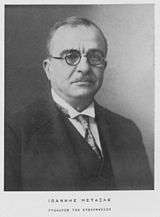Far-right politics
Far-right politics, also referred to as the extreme right or right-wing extremism,[1][2] are politics further on the right of the left–right political spectrum than the standard political right, particularly in terms of extreme nationalism,[3][4] nativist ideologies and authoritarian tendencies.[5][6]
| Part of the Politics series | ||||||
| Party politics | ||||||
|---|---|---|---|---|---|---|
| Political spectrum | ||||||
|
||||||
| Party platform | ||||||
|
||||||
| Party system | ||||||
|
|
||||||
| Coalition | ||||||
|
|
||||||
| Lists | ||||||
| Politics portal | ||||||
Historically used to describe the experiences of fascism and Nazism,[7] today far-right politics includes neo-fascism, neo-Nazism, Third Position, the alt-right, white nationalism,[8] and other ideologies or organizations that feature aspects of ultranationalist, chauvinist, xenophobic, theocratic, racist, homophobic, anti-communist, or reactionary views.[9]
Far-right politics can lead to oppression, violence, forced assimilation, ethnic cleansing and even genocide against groups of people based on their supposed inferiority, or their perceived threat to the native ethnic group,[10][11] nation, state,[12] national religion, dominant culture, or ultra-conservative traditional social institutions.[13]
Definition

The core of the far-right's worldview is organicism, the idea that society functions as a complete, organized and homogeneous living being. Adapted to the community they wish to constitute or reconstitute (whether based on ethnicity, nationality, religion or race), the concept leads them to reject every form of universalism in favor of autophilia and alterophobia, in other words the idealization of a "we" excluding a "they".[14] The far-right thus tends to absolutize differences between nations, races, individuals or cultures since they disrupt their efforts towards the utopian dream of the "closed" and naturally organized society, perceived as the condition to ensure the rebirth of a community finally reconnected to its quasi-eternal nature and re-established on firm metaphysical foundations.[5][15]
As they view their community in a state of decay facilitated by the ruling elites, far-right members portray themselves as a natural, sane and alternative elite, with the redemptive mission of saving society from its promised doom. They reject both their national political system and the global geopolitical order (including their institutions and values; e.g. political liberalism and egalitarian humanism), which are presented as needing to be abandoned or purged of their impurities, so that the "redemptive community" can eventually leave the current phase of liminal crisis to usher in the new era.[14][15] The community itself is idealized through great archetypal figures (the Golden Age, the savior, decadence, global conspiracies), as they glorify irrationalistic and non-materialistic values such as the youth or the cult of the dead.[14]
Political scientist Cas Mudde argues that the far-right can be viewed as a combination of four broadly defined concepts: exclusivism (e.g., racism, xenophobia, ethnocentrism, or ethnopluralism); antidemocratic and non-individualist traits (e.g., cult of personality, hierarchism, monism, populism, antipartyism, an organicist view of the state); a traditionalist value system lamenting the disappearance of historic frames of reference (e.g., law and order, the family, the ethnic, linguistic and religious community and nation, as well as the natural environment); and a socioeconomic program associating corporatism, state control of certain sectors, agrarianism and a varying degree of belief in the free play of socially darwinistic market forces. Mudde then proposes a subdivision of the far-right nebula into moderate and radical leanings, according to their degree of exclusionism and essentialism.[16][17]
Relying on those concepts, far-right politics includes but is not limited to aspects of authoritarianism, anti-communism and nativism.[6] Claims that superior people should have greater rights than inferior people are often associated with the far-right, as they have historically favored a darwinistic or elitist hierarchy based on the belief in the legitimacy of the rule of a supposed superior minority over the inferior masses.[18] Regarding the socio-cultural dimension of nationality, culture and migration, one far-right position is the view that certain ethnic, racial or religious groups should stay separate and it is based on the belief that the interests of one's own group should be prioritized.[19]
Modern debates
Terminology
According to Jean-Yves Camus and Nicolas Lebourg, the modern ambiguities in the definition of the "far-right" lie in the fact that the concept is generally used by political adversaries to "disqualify and stigmatize all forms of partisan nationalism by reducing them to the historical experiments of Italian Fascism [and] German National Socialism."[20] While the existence of such a political position is widely accepted among scholars, figures associated with the far-right rarely accept this denomination, preferring terms like "national movement" or "national right".[21] There is also debate about how appropriate the labels fascist or neo-fascist are. In the words of Mudde, "the labels Neo-Nazi and to a lesser extent neo-Fascism are now used exclusively for parties and groups that explicitly state a desire to restore the Third Reich or quote historical National Socialism as their ideological influence".[22]
One issue is whether parties should be labelled radical or extreme, a distinction that is made by the Federal Constitutional Court of Germany when determining whether or not a party should be banned: an extremist party opposes liberal democracy and the constitutional order, while a radical one accepts free elections and the parliament as legitimate structures.[nb 1] After a survey of the academic literature, Mudde concluded in 2002 that the terms "right-wing extremism", "right-wing populism", "national populism", or "neo-populism" were often used as synonyms by scholars, in any case with "striking similarities", except notably among a few authors studying the extremist-theoretical tradition.[nb 2] The label "radical right" is also used in the US tradition, although it has a broader meaning in America than in Europe.[nb 3]
Relation to right-wing politics
Another question is what the label "right" implies when it is applied to the extreme right, given the fact that many parties that were originally labeled right-wing extremist tended to advance neoliberal and free market agendas as late as the 1980s, but now advocate economic policies which are more traditionally associated with the left such as anti-globalization, nationalization and protectionism. One approach, drawing on the writings of Norberto Bobbio, argues that attitudes towards political equality are what distinguish the left from the right and they therefore allow these parties to be positioned on the right of the political spectrum.[23]
Aspects of far-right ideology can be identified in the agenda of some contemporary right-wing parties, in particular the idea that superior persons should dominate society while undesirable elements should be purged—which in extreme cases resulted in genocides.[24] Charles Grant, director of the Centre for European Reform in London, has distinguished between right-wing nationalist parties—which are often described as far-right such as the National Front in France—and fascism.[3] Mudde notes that the most successful European far-right parties in 2019 were "former mainstream right-wing parties that have turned into populist radical right ones."[25] According to historian Mark Sedgwick, "There is no general agreement as to where the mainstream ends and the extreme starts, and if there ever had been agreement on this, the recent shift in the mainstream would challenge it."[26]
Proponents of the horseshoe theory interpretation of the left–right spectrum identify the far-left and the far-right as having more in common with each other as extremists than each of them has with moderate centrists.[27] However, the horseshoe theory does not enjoy support within academic circles[28] and has received criticism,[28][29][30] including the view that it has been centrists who have supported far-right and fascist regimes that they prefer in power over socialist ones.[31]
History
Europe
Background
The current admitted divisions on the political spectrum come from the different positions held by elected representatives regarding the outcomes of the French Revolution. The democrats and proponents of universal suffrage were located on the left side of the elected Assembly while monarchists seated farthest to the right.[21]
Those who advocated a return to the absolute monarchy during the 19th century called themselves "ultra-monarchists" and embraced a "mystic" and "providentialist" vision of the world where royal dynasties were seen as the "repositories of divine will". The counter-revolutionary and the liberal camps began to transcend the borders of Europe during the first globalization (1870–1914) and a number of the ideas that currently constitute the foundation of far-right ideology—nationalism, populism, or antisemitism—were defended at that time by parts of the revolutionary left, a confusion observable in the writings of Georges Sorel, Robert Michels, Ludwig Woltmann, or Pierre-Joseph Proudhon.[32][33][34]
Emergence
The word extremist to designate a category of the political spectrum appeared in the French public debate following the Bolshevik Revolution of 1917.[nb 4] Far right was used at that time to describe the strongest opponents of the far left, i.e. those who supported the events occurring in Russia.[5] A number of thinkers on the far-right nonetheless claimed an influence from an anti-Marxist and anti-egalitarian definition of socialism, based on a military comradeship that rejected Marxist class analysis,[nb 5] and sometimes described by scholars as a form of "socialist revisionism".[35] They included Charles Maurras, Benito Mussolini, Arthur Moeller van den Bruck and Ernst Niekisch.[36][37][38] Those thinkers eventually split along nationalist lines from the original communist movement, Karl Marx and Friedrich Engels contradicting nationalist theories with the idea that "the working men [had] no country".[39] The main reason for that ideological confusion can be found in the consequences of the Franco-Prussian War of 1870, which according to Swiss historian Philippe Burrin had completely redesigned the political landscape in Europe by diffusing the idea of an anti-individualistic concept of "national unity" rising above the right and left division.[38]
As the concept of "the masses" was introduced into the political debate through industrialization and the universal suffrage, a new right-wing founded on national and social ideas began to emerge, what Zeev Sternhell has called the "revolutionary right", and a foreshadowing of fascism. The rift between the left and nationalists was furthermore accentuated by the emergence of anti-militarist and anti-patriotic movements like anarchism or syndicalism, which shared even less similarities with the far-right.[39] The latter began to develop a "nationalist mysticism" entirely different from that on the left, and antisemitism turned into a credo of the far-right, marking a break from the traditional economic "anti-Judaism" defended by parts of the far-left, in favor of a racial and pseudo-scientific notion of alterity. Various nationalist leagues began to form across Europe like the Pan-German League or the Ligue des Patriotes, with the common goal of a uniting the masses beyond social divisions.[40][41]
Völkisch and revolutionary right
_-_Fondo_Mar%C3%ADn-Kutxa_Fototeka.jpg)
The Völkisch movement emerged in the late 19th century, drawing inspiration from German Romanticism and its fascination for a medieval Reich supposedly organized into a harmonious hierarchical order. Erected on the idea of "blood and soil", it was a racialist, populist, agrarian, romantic nationalist and–as a consequence of a growing exclusive and racial connotation–an antisemitic movement from the 1900s onward.[42] They idealized the myth of an "original nation", that still could be found at their times in the rural regions of Germany, a form of "primitive democracy freely subjected to their natural elites."[37] Thinkers led by Arthur de Gobineau, Houston Stewart Chamberlain, Alexis Carrel and Georges Vacher de Lapouge distorted Darwin's theory of evolution to advocate a "race struggle" and an hygienist vision of the world. The purity of the bio-mystical and primordial nation theorized by the Völkischen then began to be seen as corrupted by foreign elements, Jewish in particular.[42]
Translated in Maurice Barrès' concept of "the earth and the dead", these ideas influenced the pre-fascist "revolutionary right" across Europe. The latter had its origin in the fin de siècle intellectual crisis and, in the words of Fritz Stern, the deep "cultural despair" of thinkers feeling uprooted within the rationalism and scientism of the modern world.[43] It was characterized by a rejection of the established social order, with revolutionary tendencies and anti-capitalist stances; a populist and plebiscitary dimension; the advocacy of violence as a means of action; and a call for individual and collective palingenesis.[44]
Post-World War II
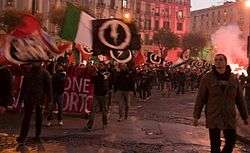
The far-right has maintained a continuous political presence in Italy since the fall of Mussolini. The neo-fascist party Italian Social Movement (1946–1995), influenced by the previous Italian Social Republic (1943–1945), became one of the chief reference points for the European far-right from the end of World War II until the late 1980s.[45] In a 1961 book deemed influential in the European far-right at large, French neo-fascist writer Maurice Bardèche introduced the idea that fascism could survive the 20th century under a new metapolitical guise adapted to the changes of the times. Rather than trying to revive doomed regimes with their single party, secret police or public display of Caesarism, Bardèche argued that its theorists should promote the core philosophical idea of fascism regardless of its framework,[15] that is the concept that only a minority, "the physically saner, the morally purer, the most conscious of national interest", Bardèche says, can represent best the community and serve the less gifted in what he calls a new "feudal contract".[46]
Silvio Berlusconi and his Forza Italia party dominated politics from 1994. According to some scholars, it gave neo-fascism a new respectability.[47] Caio Giulio Cesare Mussolini, great-grandson of Benito Mussolini, stood for the 2019 European Parliament election as a member of the far-right Brothers of Italy party.[47] In 2011, it was estimated that the neo-fascist CasaPound party had 5,000 members.[48] The name is derived from the fascist poet Ezra Pound. It has also been influenced by the Manifesto of Verona, the Labour Charter of 1927 and social legislation of fascism.[49] There has been collaboration between CasaPound and the identitarian movement.[50] The European migrant crisis has become an increasingly divisive issue in Italy.[51] Interior Minister Matteo Salvini has been courting far-right voters. His Northern League party has become an anti-immigrant, nationalist movement. Both parties are using Mussolini nostalgia to further their aims.[47]
In 1945, the Allied powers took control of Germany and banned the swastika, the Nazi Party and the publication of Mein Kampf. Today, explicitly Nazi and neo-Nazi organisations are banned in Germany.[52] In 1960, the West German parliament voted unanimously to "make it illegal to incite hatred, to provoke violence, or to insult, ridicule or defame 'parts of the population' in a manner apt to breach the peace". Today, German law outlaws anything that "approves of, glorifies or justifies the violent and despotic rule of the National Socialists".[52] Section 86a of the Germany Strafgesetzbuch (Criminal Code) outlaws any "use of symbols of unconstitutional organizations" outside the contexts of "art or science, research or teaching". The law primarily outlaws the use of Nazi symbols, flags, insignia, uniforms, slogans and forms of greeting.[53] Today, the German far-right consists of various small parties and two larger groups, namely Alternative for Germany (AfD) and the Patriotic Europeans Against the Islamisation of the Occident (Pegida).[52][54][55][56]
International
Africa
Rwanda
A number of far-right extremist and paramilitary groups carried out the Rwandan genocide under the racist supremacist ideology of Hutu power, developed by journalist and Hutu supremacist Hassan Ngeze.[57]
On 5 July 1975, exactly two years after the 1973 Rwandan coup d'état the far-right National Republican Movement for Democracy and Development (Mouvement républicain national pour la démocratie et le développement) was founded under President Juvénal Habyarimana. Between 1975 and 1991, the MRND was the only legal political party in the country. It was dominated by Hutus, particularly from Habyarimana's home region of Northern Rwanda. An elite group of MRND party members who were known to have influence on the President and his wife Agathe Habyarimana are known as the akazu, an informal organization of Hutu extremists whose members planned and lead the 1994 Rwandan genocide.[58][59]
The Interahamwe was formed around 1990 as the youth wing of the MRND, and enjoyed the backing of the Hutu Power government. The Interahamwe were the main perpetrators of the Rwandan genocide, during which an estimated 500,000 to 1,000,000 Tutsi, Twa, and moderate Hutus were killed from April to July 1994, and the term "Interahamwe" was widened to mean any civilian bands killing Tutsi.[60][61] The Interahamwe were driven out of Rwanda after Tutsi-led Rwandan Patriotic Front (RPF) victory in the Rwandan Civil War in July 1994, and are considered a terrorist organisation by many African and Western governments. The Interahamwe and splinter groups such as the Democratic Forces for the Liberation of Rwanda (FDLR) continue to wage an insurgency against Rwanda from neighboring countries, where they are also involved in local conflicts and terrorism.
Other far-right groups and paramilitaries involved included the anti-democratic segregationist Coalition for the Defence of the Republic which called for complete segregation of Hutus from Tutsis. The Coalition for the Defence of the Republic had a paramilitary wing, the Impuzamugambi. Together with the Interahamwe militia, the Impuzamugambi played a central role in the Rwandan genocide.[62][57]
South Africa
The far-right in South Africa emerged as the Herstigte Nasionale Party (HNP) in 1969, formed by Albert Hertzog as breakaway from the predominant right-wing South African National Party (NP) an Afrikaner ethno-nationalist party that implemented the racist, segregationist program of apartheid—the legal system of political, economic and social separation of the races intended to maintain and extend political and economic control of South Africa by the White minority.[63] The HNP was formed after the South African National Party re-established diplomatic relations with Malawi and legislated to allow Māori players and spectators to enter the country during the 1970 New Zealand rugby union team tour in South Africa.[64] The HNP advocated for a Calvinist, racially segregated, Afrikaans speaking nation. [65]
In 1973, Eugène Terre'Blanche, a former police officer founded The Afrikaner Weerstandsbeweging (Afrikaner Resistance Movement) (AWB), a South African neo-Nazi paramilitary organisation, often described as a White Supremacist group.[66][67][68] Since its founding in 1973 by Eugène Terre'Blanche and six other far-right Afrikaners, it has been dedicated to secessionist Afrikaner nationalism and the creation of an independent Boer-Afrikaner republic in part of South Africa. During negotiations to end apartheid in South Africa in the early 1990s, the organisation terrorised and killed black South Africans.[69]
Togo
Togo has been ruled by members of the Gnassingbé family and the far-right military dictatorship formerly known as the Rally of the Togolese People (RTP) since 1969. Despite the legalisation of political parties in 1991 and the ratification of a democratic constitution in 1992, the regime continues to be regarded as oppressive, and in 1993 the EU cut off aid in reaction to the regime's human-rights offenses. After's Eyadema's death in 2005 his son, Faure Gnassingbe, took over, then stood down and was re-elected in elections that were widely described as fraudulent and occasioned violence that resulted in as many as 600 deaths and the flight from Togo of 40,000 refugees.[70] In 2012 Faure Gnassingbe dissolved the RTP and created the Union for the Republic (UNIR).[71][72][73]
Throughout the reign of the Gnassingbé family, Togo has been extremely oppressive. According to a U.S. State Department report based on conditions in 2010, human rights abuses are common and include "security force use of excessive force, including torture, which resulted in deaths and injuries; official impunity; harsh and life-threatening prison conditions; arbitrary arrests and detention; lengthy pretrial detention; executive influence over the judiciary; infringement of citizens' privacy rights; restrictions on freedoms of press, assembly, and movement; official corruption; discrimination and violence against women; child abuse, including female genital mutilation (FGM), and sexual exploitation of children; regional and ethnic discrimination; trafficking in persons, especially women and children; societal discrimination against persons with disabilities; official and societal discrimination against homosexual persons; societal discrimination against persons with HIV; and forced labor, including by children."[74]
America
Brazil
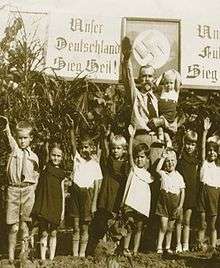
Prior to World War II, Nazis had been making and distributing propaganda among ethnic Germans in Brazil. The Nazi regime built close ties with Brazil through the estimated 100 thousand native Germans and 1 million German descendants living in Brazil at the time.[75] In 1928, the Brazilian section of the Nazi Party of Germany was founded in Timbó, Santa Catarina. This section reached 2,822 members and was the largest section of the German Nazi Party outside Germany.[76][77][78] About 100 thousand born Germans and about one million descendants lived in Brazil at that time.[79]
During the 1920s and 1930s, a local brand of religious fascism appeared known as Integralism a green-shirted paramilitary organization with uniformed ranks, highly regimented street demonstrations and rhetoric against Marxism and liberalism.[80][81]
After Germany's defeat in World War II, many Nazi war criminals fled to Brazil and hid among the German-Brazilian communities. The most famous case was Josef Mengele, a doctor who became known as the "Angel of Death" at the Auschwitz concentration camp. Mengele performed horrific medical experiments. Mengele drowned in Bertioga, on the coast of São Paulo state, without ever having been recognized.[82]
The far-right has continued to operate throughout Brazil[83] and a number of far right parties existed in the modern era including Patriota, the Brazilian Labour Renewal Party, the Party of the Reconstruction of the National Order, the National Renewal Alliance and the Social Liberal Party as well as death squads such as the Command for Hunting Communists. The current president of Brazil Jair Bolsonaro is a member of the Alliance for Brazil, a far-right nationalist political group that aims to become a political party.[84][85][86] Bolsonaro has been described by numerous media organisations as far-right.[87]
Chile
On 11 September 1973, the democratically-elected government of Salvador Allende was overthrown in a US-backed coup d'état. From 11 September 1973 until 11 March 1990, the country was ruled by the far-right Government Junta of Chile headed by General Augusto Pinochet. The military dictatorship presented its mission as a "national reconstruction." The coup was the result of multiple forces, including pressure from conservative and women's groups, certain political parties, union strikes and other domestic unrest, as well as international factors. According to an article written by lifelong CIA operative Jack Devine, although it was widely reported that the CIA was directly involved in orchestrating and carrying out the coup, subsequently released sources suggest a much reduced role of the US government.[88]
The regime was characterized by the systematic suppression of political parties and the persecution of dissidents to an extent unprecedented in the history of Chile. Overall, the regime left over 3,000 dead or missing, tortured tens of thousands of prisoners,[89] and drove an estimated 200,000 Chileans into exile.[90][91]
Central American death squads
In Guatamala, the far-right government of Carlos Castillo Armas utilised [[death squads after coming to power in the 1954 Guatemalan coup d'état.[92][93] Along with other far-right extremists, Castillo Armas started the National Liberation Movement (Movimiento de Liberación Nacional, or MLN). The founders of the party described it as the "party of organized violence."[94] The new government promptly reversed the democratic reforms initiated during the Guatemalan Revolution and the agrarian reform program that was the main project of president Jacobo Arbenz Guzman and which directly impacted the interests of both the United Fruit Company and the Guatemalan landowners.[95]
Mano Blanca, otherwise known as the Movement of Organized Nationalist Action, was set up in 1966 as a front for the MLN to carry out its more violent activities,[96][97] along with many other similar groups, including the New Anticommunist Organization and the Anticommunist Council of Guatemala.[94][98] Mano Blanca was active during the governments of colonel Carlos Arana Osorio and general Kjell Laugerud García and was dissolved by general Fernando Romeo Lucas Garcia in 1978.[99]
Armed with the support and coordination of the Guatemalan Armed Forces, Mano Blanca began a campaign described by the United States Department of State as one of "kidnappings, torture, and summary execution."[97] One of the main targets of Mano Blanca was the Partido Revolucionario (PR), an anti-communist group that was the only major reform oriented party allowed to operate under the military-dominated regime. Other targets included the banned leftist parties.[97] Human rights activist Blase Bonpane described the activities of Mano Blanca as being an integral part of the policy of the Guatemalan government, and by extension the policy of the United States government and the Central Intelligence Agency.[95][100] Overall, Mano Blanca was responsible for thousands of murders and kidnappings, leading travel writer Paul Theroux to refer to them as "Guatemala's version of a volunteer Gestapo unit."[101]
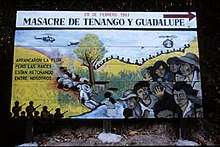
During the Salvadoran civil war, far-right death squads (known in Spanish by the name of Escuadrón de la Muerte, "Squadron of Death") achieved notoriety when a sniper assassinated Archbishop Óscar Romero while he was saying Mass in March 1980. In December 1980, three American nuns and a lay worker were gangraped and murdered by a military unit later found to have been acting on specific orders. Death squads were instrumental in killing thousands of peasants and activists. Funding for the squads came primarily from right-wing Salvadoran businessmen and landowners.[102]
El Salvadorian death squads indirectly received U.S. arms, funding, training and advice during the Carter, Reagan and George H. W. Bush administrations.[103] Some death squads such as Sombra Negra are still operating in El Salvador.[104]
Honduras also had far-right death squads active through the 1980s, the most notorious of which was Battalion 3–16. Hundreds of people, teachers, politicians, and union bosses were assassinated by government-backed forces. Battalion 316 received substantial support and training from the United States Central Intelligence Agency.[105] At least 19 members were School of the Americas graduates.[106][107] Seven members, including Billy Joya, later played important roles in the administration of President Manuel Zelaya as of mid-2006.[108] Following the 2009 coup d'état, former Battalion 3–16 member Nelson Willy Mejía Mejía became Director-General of Immigration[109][110] and Billy Joya was de facto President Roberto Micheletti's security advisor.[111] Another former Battalion 3–16 member, Napoleón Nassar Herrera,[108][112] was high Commissioner of Police for the north-west region under Zelaya and under Micheletti, and also became a Secretary of Security spokesperson "for dialogue" under Micheletti.[113][114] Zelaya claimed that Joya had reactivated the death squad, with dozens of government opponents having been murdered since the ascent of the Michiletti and Lobo governments.[111]
Mexico
The largest far-right party in Mexico is the National Synarchist Union. It was historically a movement of the Roman Catholic extreme right, in some ways akin to clerical fascism and falangism, implacably opposed to the left wing and secularist policies of the Institutional Revolutionary Party (PRI) and its predecessors that governed Mexico from 1929 to 2000 and 2012 to 2018.[115][116]
United States
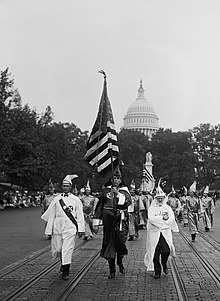
The term far-right, along with extreme right and ultra-right, has been used in the United States to describe "militant forms of insurgent revolutionary right ideology and separatist ethnocentric nationalism", such as the Ku Klux Klan, Christian Identity, the Creativity Movement, the National Socialist Movement, or the National Alliance.[117] They share conspiracist views of power which are overwhelmingly antisemitic and reject pluralist democracy in favour of an organic oligarchy that would unite the perceived homogeneously-racial Völkish nation.[117]
Starting in the 1870s and continuing through the late 19th century, numerous white supremacist paramilitary groups operated in the South, with the goal of organizing against and intimidating supporters of the Republican Party. Examples of such groups included the Red Shirts and the White League. The Second Ku Klux Klan, which was formed in 1915, combined Protestant fundamentalism and moralism with right-wing extremism. Its major support came from the urban south, the midwest and the Pacific Coast.[118] While the Klan initially drew upper middle class support, its bigotry and violence alienated these members and it came to be dominated by less educated and poorer members.[119]
The Klan claimed that there was a secret Catholic army within the United States loyal to the Pope, that one million Knights of Columbus were arming themselves, and that Irish-American policemen would shoot Protestants as heretics. They claimed that the Catholics were planning to take Washington and put the Vatican in power, and that all presidential assassinations had been carried out by Catholics. The prominent Klan leader, D. C. Stephenson claimed that international Jewish bankers were behind the World War I and planned to destroy economic opportunities for Christians. Other Klansmen claimed that the Russian Revolution and communism were controlled by Jews. They frequently reprinted parts of The Protocols of the Elders of Zion and New York City was condemned as an evil city controlled by Jews and Catholics. The objects of Klan fear tended to vary by locale and included Catholics, Jews, African Americans, Wobblies, Orientals, labour unions and liquor. They were also anti-elitist and attacked "the intellectuals", seeing themselves as egalitarian defenders of the common man.[120]
During the Great Depression there were a large number of small nativist groups, whose ideologies and bases of support were similar to those of earlier nativist groups. However, proto-fascist movements such as Huey Long's Share Our Wealth and Father Coughlin's National Union for Social Justice emerged, which differed from other right-wing groups by attacking big business, calling for economic reform and rejecting nativism. However, Coughlin's group later developed a racist ideology.[121]
Although small militias had existed throughout the latter half of the 20th century, the groups became more popular during the early 1990s, after a series of standoffs between armed citizens and federal government agents, such as the 1992 Ruby Ridge siege and 1993 Waco Siege. These groups expressed concern for what they perceived as government tyranny within the United States and generally held libertarian and constitutionalist political views, with a strong focus on the Second Amendment gun rights and tax protest. They also embraced many of the same conspiracy theories as predecessor groups on the radical right, particularly the New World Order theory. Currently active examples of such groups are the 3 Percenters and the Oath Keepers. A minority of militia groups, such as Posse Comitatus and the Aryan Nations, were white nationalists and saw militia and patriot movements as a form of white resistance against what they perceived to be a liberal and multiculturalist government. More recently, militia and patriot organizations were involved in the 2014 Bundy standoff and the 2016 Occupation of the Malheur National Wildlife Refuge.[122][123]
_crop.jpg)
After the September 11 attacks in 2001, the Counterjihad movement, supported by groups such as Stop Islamization of America and individuals such as Frank Gaffney and Pamela Geller, began to gain traction among the American right. They were widely dubbed Islamophobic for their vocal condemnation of the Islamic faith and their belief that there was a significant threat posed by Muslims living in America. They believed the United States was under threat from 'Islamic supremacism', accusing the Council on American-Islamic Relations and even prominent conservatives like Suhail A. Khan and Grover Norquist of supporting radical Islamists such as the Muslim Brotherhood.
The alt-right emerged during the 2016 election cycle in support of the Donald Trump presidential campaign. It draws influence from paleoconservatism, paleolibertarianism, white nationalism, the manosphere, Identitarianism and the neoreactionary movement, and differs from previous radical right movements due to its heavy internet presence on sites such as 4chan.
Asia
Japan
In 1996, the National Police Agency estimated that there were over 1,000 extremist right-wing groups in Japan, with about 100,000 members in total. These groups are known in Japanese as Uyoku dantai. While there are political differences among the groups, they generally carry a philosophy of anti-leftism, hostility towards People's Republic of China, North Korea, and South Korea, and justification of Japan's role in World War II. Uyoku dantai groups are well known for their highly visible propaganda vehicles fitted with loudspeakers and prominently marked with the name of the group and propaganda slogans. The vehicles play patriotic or wartime-era songs.
Activists affiliated with such groups have used Molotov cocktails and time bombs to intimidate moderate politicians and public figures, including former Deputy Foreign Minister Hitoshi Tanaka and Fuji Xerox Chairman Yotaro Kobayashi. An ex-member of a right-wing group set fire to LDP politician Koichi Kato's house. Koichi Kato and Yotaro Kobayashi had spoken out against Koizumi's visits to Yasukuni Shrine.[124]
Openly revisionist, Nippon Kaigi is considered "the biggest right-wing organization in Japan".[125][126]
Europe
Croatia
Individuals and groups in Croatia that employ far-right politics are most often associated with the historical Ustaše movement, hence they have connections to Neo-Nazism and neo-fascism. That World War II political movement was an extremist organization at the time supported by the German Nazis and the Italian Fascists. The association with the Ustaše has been called "Neo-Ustashism" by Slavko Goldstein.[127]
Greece
The far-right in Greece first came to power under the ideology of Metaxism a proto-fascist ideology developed by dictator Ioannis Metaxas.[128] Metaxism called for the regeneration of the Greek nation and the establishment of an ethnically homogeneous state.[129] Metaxism disparaged liberalism, and held individual interests to be subordinate to those of the nation, seeking to mobilize the Greek people as a disciplined mass in service to the creation of a "new Greece."[129]
Metaxas declared that his 4th of August Regime (1936–1941) represented a "Third Greek Civilization" which was committed to the creation of a culturally purified Greek nation based upon the militarist societies of ancient Macedonia and Sparta, which he held to constitute the "First Greek Civilization"; and the Orthodox Christian ethic of the Byzantine Empire, which he considered to represent the "Second Greek Civilization."[129] The Metaxas regime asserted that true Greeks were ethnically Greek and Orthodox Christian, intending to deliberately exclude Albanians, Slavs, and Turks residing in Greece from Greek citizenship.[129]
The Metaxas government and its official doctrines are often described as Fascist, academically it is considered to have been a conventional totalitarian-conservative dictatorship akin to Francisco Franco's Spain or António de Oliveira Salazar's Portugal.[128][130] The Metaxist government derived its authority from the conservative establishment and its doctrines strongly supported traditional institutions such as the Greek Orthodox Church and the Greek Royal Family; essentially reactionary, it lacked the radical theoretical dimensions of ideologies such as Italian Fascism and German Nazism.[128][130]
The ideology of Metaxism was associated with Metaxas' political party, the Freethinkers' Party and the 4th of August Regime.[131] In the post-war period it has been advocated by the 4th of August Party, the Golden Dawn party, Popular Greek Patriotic Union and the ELAM party.
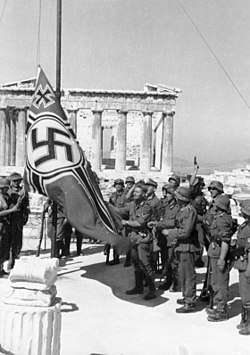
The Metaxis regime came to an end after the Axis powers invaded Greece. The Axis occupation of Greece began in April 1941 after Nazi Germany invaded Greece to assist its ally, Fascist Italy, which had been at war with Allied Greece since October 1940. Following the conquest of Crete, all of Greece was occupied by June 1941.[132] The occupation in the mainland lasted until Germany and its ally Bulgaria were forced to withdraw under Allied pressure in early October 1944. However, German garrisons remained in control of Crete and some other Aegean islands until after the end of World War II in Europe, surrendering these islands in May and June 1945.[133]
Fascist Italy had initially declared war and invaded Greece in October 1940, but the Hellenic Army initially managed to push back the invading forces into neighboring Albania, then an Italian protectorate. Nazi Germany intervened on its ally's behalf in southern Europe. While most of the Hellenic Army was dislocated on the Albanian front to fend off the relentless Italian counter-attacks, a rapid German Blitzkrieg campaign commenced in April 1941, and by June (with the conquest of Crete) Greece was defeated and occupied. The Greek government went into exile, and an Axis collaborationist puppet government was established in the country. Furthermore, Greece's territory was divided into occupation zones run by the Axis powers, with the Germans proceeding to administer the most important regions of the country themselves, including Athens, Thessaloniki and the strategic Aegean Islands. Other regions of the country were given to Germany's partners, Italy and Bulgaria.[134]
The occupation ruined the Greek economy and brought about terrible hardships for the Greek civilian population.[135] Much of Greece was subjected to enormous destruction of its industry (80% of which was destroyed), infrastructure (28% destroyed), ports, roads, railways and bridges (90%), forests and other natural resources (25%)[136][137][138] and loss of civilian life (7.02% – 11.17% of its citizens).[139][140] Over 40,000 civilians died in Athens alone from starvation, and tens of thousands more died from reprisals by Nazis and collaborators.[141] The Jewish population of Greece was nearly eradicated. Of its pre-war population of 75–77,000, only around 11–12,000 survived, either by joining the resistance or being hidden.[142] Most of those who died were deported to Auschwitz, while those in Thrace, under Bulgarian occupation, were sent to Treblinka. The Italians did not deport Jews living in territory they controlled, but when the Germans took over, Jews living there were also deported.[143]
Following the short-lived interim government of Georgios Papandreou, the far-right again seized power in Greece during the 1967 Greek coup d'état murdering Papandreou and replacing the interim government with the far-right, US backed Greek junta. The Junta was a series of far-right military juntas that ruled Greece from 1967 to 1974. On 21 April 1967, a group of colonels overthrew The dictatorship was characterised by right-wing cultural policies, restrictions on civil liberties, and the imprisonment, torture, and exile of political opponents. An attempt to renew its support in a 1973 referendum on the monarchy and gradual democratisation was ended by another coup by hardliner Dimitrios Ioannidis. The junta's rule ended on 24 July 1974 under the pressure of the Turkish invasion of Cyprus, leading to the Metapolitefsi ("regime change") to democracy and the establishment of the Third Hellenic Republic.[144][145]
Today, the dominant far-right party in Greece today is the neo-Nazi, Mataxist inspired Golden Dawn.[146] At the May 2012 Greek legislative election Golden Dawn won a number of seats in the Greek parliament, the party received 6.92% of the vote.[147][148] Founded by Nikolaos Michaloliakos, Golden Dawn had its origins in the movement that worked towards a return to right-wing military dictatorship in Greece. Following an investigation into the 2013 murder of Pavlos Fyssas, an anti-fascist rapper, by a supporter of the party,[149] Michaloliakos and several other Golden Dawn MPs and members were arrested and held in pre-trial detention on suspicion of forming a criminal organization.[150] The trial began on 20 April 2015[151] and is ongoing as of 2019. Golden Dawn later lost all of its remaining seats in the Greek Parliament in the 2019 Greek legislative election.[152] A 2020 survey showed the party's popularity plummeting to just 1.5%, down from 2.9% in previous year's elections.[153]
Hungary
The Kingdom of Hungary was an Axis Power during World War II. However, by 1944 Hungary was in secret negotiations with the Allies. Upon discovering these secret negotiations Germany invaded Hungary in March 1944, effectively sabotaging the attempts to jump out of the war, until the Soviet invasion started later that same year.[154]
Hungary's largest far-right organisation is the Movement for a Better Hungary, commonly known as Jobbik. Jobbik is a radical Hungarian nationalist party.[155][156][157] The party describes itself as "a principled, conservative and radically patriotic Christian party", whose "fundamental purpose" is the protection of "Hungarian values and interests".[158] In 2014, the party has been described as an "anti-Semitic organization" by The Independent and a "neo-Nazi party" by the president of the European Jewish Congress.[159]
Netherlands
Despite being neutral, the Netherlands was invaded by Nazi Germany on 10 May 1940, as part of Fall Gelb.[160] About 70% of the country's Jewish population were killed during the occupation, a much higher percentage than comparable countries, such as Belgium and France.[161] Most of the south of the country was liberated in the second half of 1944. The rest, especially the west and north of the country still under occupation, suffered from a famine at the end of 1944, known as the "Hunger Winter". On 5 May 1945, the whole country was finally liberated by the total surrender of all German forces.
Since the end of WWII the Netherlands has had a number of small far-right groups and parties, the largest and most successful being the Party for Freedom lead by Geert Wilders.[162] Other far right Dutch groups include the neo-Nazi Dutch Peoples-Union (1973-current),[163] the Centre Party (1982-1986), the Centre Party '86 (1986-1998), the Dutch Block (1992-2000), New National Party (1998-2005) and the ultranationalist National Alliance (2003-2007).[164][165]
Poland
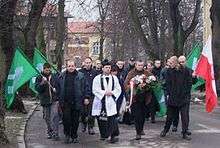
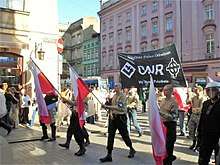
Following the collapse of a communist system in the country, the far-right ideology became visible. The pan-Slavic and neopagan Polish National Union (PWN-PSN) political party at its peak was one of the larger groups active in the early 1990s, numbering then some 4,000 members and making international headlines for its anti-Semitism and anti-Catholicism. The National Revival of Poland being a marginal political party, under the leadership of Adam Gmurczyk, operates since the late 1980s. It is a member of European National Front and a co-founder of International Third Position. The organization Association for Tradition and Culture "Niklot" was founded in 1998 by Tomasz Szczepanski, a former NOP member, promoting Slavic supremacy and neopaganism. Since the mid-1990s, the ultra-Catholic Radio Maryja station has been on air with an anti-modernist, nationalist and xenophobic program.[166] All-Polish Youth and National Radical Camp were "recreated" in 1989 and 1993, respectively becoming Poland's most prominent far-right organizations.
In 1995, the Anti-Defamation League estimated the number of far-right skinheads in Poland at 2,000, the fifth highest number after Germany, Hungary, the Czech Republic and the United States.[167] Since late 2000s, native white power skinhead, white supremacy and neo-Nazi groups largely were absorbed into more casual and better organized Autonomous Nationalists.
On the political level, the biggest victories achieved so far by the far-right were in the 2001, 2005, 2015, and 2019 elections. The League of Polish Families won 38 seats in 2001, and 34 in 2005. In 2015, entering parliament from the list of Kukiz'15, the far-right National Movement gained 5 seats out of Kukiz's 42. In April 2016 National Movement leadership decided to break-off with Kukiz's movement, but only one MP followed the party's instructions. The ones that decided to stay with Kukiz'15, together with few other Kukiz's MPs, formed parliamentary nationalist association called National Democracy (Endecja).[168] In 2019, the Confederation had the best performance of any far-right coalition to date, earning 1,256,953 votes which was 6.81% of the total vote in an election that saw a historically high turnout. Together the coalition (although de-jure a party) earned 11 seats, 5 for KORWiN, 5 for National Movement, and 1 for Confederation of the Polish Crown.
Members of far-right groups make up a significant portion of those taking part in the annual "Independence March" in central Warsaw, which started in 2009, to mark Independence Day. About 60,000 were in the 2017 march marking the 99th anniversary of independence, with placards such as "Clean Blood" seen on the march.[169]
Romania
The preimenant far-right party in Romania is Greater Romania Party, founded in 1991 by Tudor, who was formerly known as a "court poet" of communist dictator Nicolae Ceaușescu,[170] and his literary mentor, the writer Eugen Barbu, one year after Tudor launched the România Mare weekly magazine, which remains the most important propaganda tool of the PRM. Tudor subsequently launched a companion daily newspaper called Tricolorul. (The historical expression Greater Romania refers to the idea of recreating the former Kingdom of Romania which existed during the interwar period. Having been the largest entity to bear the name of Romania, the frontiers were marked with the intent of uniting most territories inhabited by ethnic Romanians into a single country; and it is now a rallying cry for Romanian nationalists. Due to internal conditions under Communism after World War II, the expression's use was forbidden in publications until 1990, after the Romanian Revolution.) The party's initial success was partly attributed to the deep rootedness of Ceaușescu's national communism in Romania.[171]
Both the ideology and the main political focus of the Greater Romania Party are reflected in frequently strongly nationalistic articles written by Tudor. The party has called for the outlawing of the ethnic Hungarian party, the Democratic Union of Hungarians in Romania, for allegedly plotting the secession of Transylvania.[172]
Serbia
The far-right in Serbia mostly focuses on national and religious factors and it refers to any manifestation of far-right politics in the Republic of Serbia. Today a large number of far-right groups operate in Serbia including the Serbian Radical Party, Serbian Party Oathkeepers, Leviathan Movement, Serbian Right and the explicitly neo-Nazi Nacionalni stroj ("National Alignment"). Nacionalni stroj was banned in Serbia in 2012.[173][174][175]
United Kingdom
The British far-right rose out of the fascist movement. In 1932, Oswald Mosley founded the British Union of Fascists (BUF), which was banned during World War II.[176] Founded in 1954 by A. K. Chesterton, the League of Empire Loyalists became the main British far right group at the time. It was a pressure group rather than a political party, and did not contest elections. Most of its members were part of the Conservative Party, and they were known for politically embarrassing stunts at party conferences.[177] Other fascist parties included the National Front (NF), White Defence League and the National Labour Party who eventually merged to form the British National Party (BNP).[178]
With the decline of the British Empire becoming inevitable, British far-right parties turned their attention to internal matters. The 1950s had seen an increase in immigration to the UK from its former colonies, particularly India, Pakistan, the Caribbean and Uganda. Led by John Bean and Andrew Fountaine, the BNP opposed the admittance of these people to the UK. A number of its rallies, such as one in 1962 in Trafalgar Square, London, ended in race riots. After a few early successes, the party got into difficulties and was destroyed by internal arguments. In 1967 it joined forces with John Tyndall and the remnants of Chesterton's League of Empire Loyalists to form Britain's largest far-right organisation, the National Front (NF).[179]
The BNP and the NF supported extreme loyalism in Northern Ireland, and attracted Conservative Party members who had become disillusioned after Harold Macmillan had recognised the right to independence of the African colonies, and had criticised Apartheid in South Africa.[180]
Some Northern Irish loyalist paramilitaries have links with far-right and Neo-Nazi groups in Britain, including Combat 18,[181][182] the British National Socialist Movement,[183] and the National Front.[184] Since the 1990s, loyalist paramilitaries have been responsible for numerous racist attacks in loyalist areas.[185]
During the 1970s, the NF's rallies became a regular feature of British politics. Election results remained strong in a few working class urban areas, with a number of local council seats won, but the party never came anywhere near winning representation in parliament. Since the 1970's, the National Front's support has been in decline, whilst Nick Griffin and the BNP have grown in popularity. Around the turn of the 21st century, the BNP won a number of councillor seats. They continued their anti-immigration policy,[186] and a damaging BBC documentary led to Griffin being charged with incitement to racial hatred (although he was acquitted).[187]
Oceania
Australia
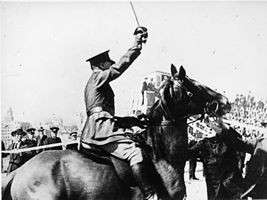
Coming to prominence in Sydney with the formation of The New Guard (1931) and the Centre Party (1933), the far-right has played a part in Australian political discourse since the second world war.[188] These proto-fascist groups were monarchist, anti-communist and authoritarian in nature. Early far-right groups were followed by the explicitly fascist Australia First Movement (1941).[189][190] The far right in Australia went on to acquire more explicitly racial connotations during the 1960s and 1970s, morphing into self-proclaimed Nazi, fascist and antisemitic movements, organisations that opposed non-white and non-Christian immigration such as the neo-Nazi National Socialist Party of Australia (1967) and the militant white supremacist group National Action (1982).[191][192][193]
Since the 1980s, the term has mainly been used to describe those who express the wish to preserve what they perceive to be Judeo-Christian, Anglo-Australian culture, and those who campaign against Aboriginal land rights, multiculturalism, immigration and asylum seekers. Since 2001 Australia has seen the development of modern neo-Nazi, neo-Fascist or alt-right groups such as the True Blue Crew, the United Patriots Front, Fraser Anning's Conservative National Party and the Antipodean Resistance.[194]
New Zealand
A small number of far-right organisations have existed in New Zealand since WWII including the Conservative Front, the New Zealand National Front and the National Democrats Party.[195][196] Far-right parties in New Zealand lack significant support, with their protests often dwarfed by counter protest.[197]
In 2019, after the Christchurch mosque shootings, the National Front like other far-right groups "publicly shut up shop"[198] and largely went underground.[199]
Fiji
The Nationalist Vanua Tako Lavo Party (NVTLP) was a Fijian political party which advoctaed Fijian ethnic nationalism. In 2009 party leader Iliesa Duvuloco was arrested for breaching the military regime's emergency laws by distributing pamphlets calling for an uprising against the military regime.[200] In January 2013 the military regime introduced regulations that essentially de-registered the party.[201][202][203]
Online
A number of far-right internet pages and forums are focused on and frequented by the far-right. These include Stormfront and Iron March.
Stormfront is the oldest and most prominent neo-Nazi website, described by the Southern Poverty Law Center as the “murder capital of the internet”.[204][205] Stormfront was the Internet's first major racial hate site.[206]
In August 2017, Stormfront was taken offline for just over a month when its registrar seized its domain name due to complaints that it promoted hatred and that some of its members were linked to murder.[207][208] The Lawyers' Committee for Civil Rights Under Law claimed credit for the action after advocating for Stormfront's web host, Network Solutions, to enforce its Terms of Service agreement which prohibits users from using its services to incite violence.[209][210]
Iron March was a fascist web forum, founded by Russian nationalist Alexander "Slavros" Mukhitdinov founded in 2011. An unknown individual uploaded a database of Iron March users to the Internet Archive in November 2019, and multiple neo-nazi users were identified, including an ICE detention center captain and several active members of the US armed forces.[211][212][213] The Southern Poverty Law Center linked Iron March to nearly 100 murders as of mid-2018.[214][211] Mukhitdinov remained a murky figure at the time of the leaks.[215]
Nature of support
Jens Rydgren describes a number of theories as to why individuals support far-right political parties and the academic literature on this topic distinguishes between demand-side theories that have changed the "interests, emotions, attitudes and preferences of voters" and supply-side theories which focus on the programmes of parties, their organization and the opportunity structures within individual political systems.[216] The most common demand-side theories are the social breakdown thesis, the relative deprivation thesis, the modernization losers thesis and the ethnic competition thesis.[217]
The rise of far-right political parties has also been viewed as a rejection of post-materialist values on the part of some voters. This theory which is known as the reverse post-material thesis blames both left-wing and progressive parties for embracing a post-material agenda (including feminism and environmentalism) that alienates traditional working class voters.[218][219] Another study argues that individuals who join far-right parties determine whether those parties develop into major political players or whether they remain marginalized.[220]
Early academic studies adopted psychoanalytical explanations for the far-right's support. For example, the 1933 publication The Mass Psychology of Fascism by Wilhelm Reich argued the theory that fascists came to power in Germany as a result of sexual repression. For some far-right political parties in Western Europe, the issue of immigration has become the dominant issue among them, so much so that some scholars refer to these parties as "anti-immigrant" parties.[221]
Right-wing terrorism

Right-wing terrorism is terrorism motivated by a variety of far right ideologies and beliefs, including anti-communism, neo-fascism, neo-Nazism, racism, xenophobia and opposition to immigration. This type of terrorism has been sporadic, with little or no international cooperation.[4] Modern right-wing terrorism first appeared in western Europe in the 1980s and it first appeared in Eastern Europe following the dissolution of the Soviet Union.[222]
Right-wing terrorists aim to overthrow governments and replace them with nationalist or fascist-oriented governments.[4] The core of this movement includes neo-fascist skinheads, far-right hooligans, youth sympathisers and intellectual guides who believe that the state must rid itself of foreign elements in order to protect rightful citizens.[222] However, they usually lack a rigid ideology.[222]
According to Cas Mudde, far-right terrorism and violence in the West have been generally perpetrated in recent times by individuals or groups of individuals "who have at best a peripheral association" with politically relevant organizations of the far-right. Nevertheless, Mudde follows, "in recent years far-right violence has become more planned, regular, and lethal, as terrorists attacks in Christchurch (2019), Pittsburgh (2018), and Utøya (2011) show."[25]
Gallery
 Supporters of the historic Russian far-right Black Hundreds movement marching in Odessa, 1905
Supporters of the historic Russian far-right Black Hundreds movement marching in Odessa, 1905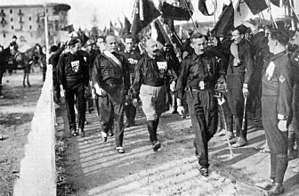
 Emblem of the National Fascist Party
Emblem of the National Fascist Party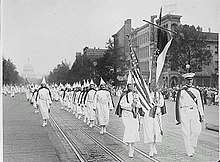 Members of the Ku Klux Klan, marching in a mass rally in Washington, D.C., 1928
Members of the Ku Klux Klan, marching in a mass rally in Washington, D.C., 1928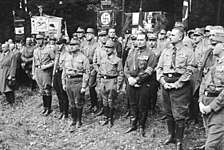 Nazis alongside members of German National People's Party (DNVP) during the Nazi–DNVP alliance in the Harzburg Front, 1931
Nazis alongside members of German National People's Party (DNVP) during the Nazi–DNVP alliance in the Harzburg Front, 1931.svg.png) The flag of Nazi Germany
The flag of Nazi Germany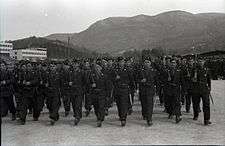 Members of the Croatian Black Legion of the Ustashe Militia in Sarajevo, 1942
Members of the Croatian Black Legion of the Ustashe Militia in Sarajevo, 1942
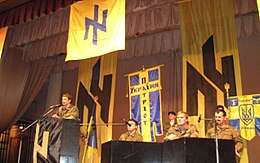 Andriy Biletsky addresses the Second Congress of the Patriot of Ukraine, Kharkiv, April 2008[223][224]
Andriy Biletsky addresses the Second Congress of the Patriot of Ukraine, Kharkiv, April 2008[223][224]
See also
- Adolf Hitler
- Alt-right
- Antifeminism
- Anticommunism
- Ethnic nationalism
- European New Right
- Extremism
- Fascism
- Far-right politics in Poland
- Far-left politics
- Far-right politics in Germany (1945–present)
- Greek Junta
- History of the far-right in Spain
- Hutu power
- Ioannis Metaxas
- Manosphere
- Metaxism
- Nazism
- Neo-Nazism
- Paul von Hindenburg
- Politics in Italy
- Radical right (United States)
- Radical right (Europe)
- Right-wing authoritarianism
- Right-wing populism
- Right-wing terrorism
- Social Darwinism
- Uyoku dantai
- White ethnostate
- White nationalism
- White power
- White supremacy
- Wingnut (politics)
References
- Mudde 2002, p. 11.
- Ignazi 2003.
- Baker, Peter (28 May 2016). "Rise of Donald Trump Tracks Growing Debate Over Global Fascism". The New York Times. ISSN 0362-4331. Retrieved 7 June 2016.
- Aubrey, Stefan M. The New Dimension of International Terrorism. p. 45. Zurich: vdf Hochschulverlag AG, 2004. ISBN 3-7281-2949-6
- Camus & Lebourg 2017, p. 21.
- Hilliard, Robert L. and Michael C. Keith, Waves of Rancor: Tuning in the Radical Right (Armonk, New York: M.E. Sharpe Inc., 1999, p. 43
- "Historical Exhibition Presented by the German Bundestag" (PDF).
- "Ctrl-Alt-Delete: The origins and ideology of the Alternative Right | Political Research Associates". www.politicalresearch.org. Retrieved 3 September 2019.
- Carlisle, Rodney P., ed., The Encyclopedia of Politics: The Left and the Right, Volume 2: The Right (Thousand Oaks, California, United States; London, England; New Delhi, India: Sage Publications, 2005) p. 693.
- Golder, Matt (11 May 2016). "Far Right Parties in Europe". Annual Review of Political Science. 19 (1): 477–497. doi:10.1146/annurev-polisci-042814-012441.
- http://mattgolder.com/files/research/arps.pdf
- Hilliard, Robert L. and Michael C. Keith, Waves of Rancor: Tuning in the Radical Right (Armonk, New York: M.E. Sharpe, Inc., 1999) p. 38.
- Davies & Lynch 2002, p. 264: "In addition, conservative Christians often endorsed far-right regimes as the lesser of two evils, especially when confronted with militant atheism in the USSR."
- Camus & Lebourg 2017, p. 22.
- Bar-On 2016, p. xiii.
- Mudde, Cas. "The Extreme Right Party Family: An Ideological Approach" (PhD diss., Leiden University, 1998).
- Camus & Lebourg 2017, pp. 44–45.
- Woshinsky 2008, pp. 154–155.
- Widfeldt, Anders, "A fourth phase of the extreme right? Nordic immigration-critical parties in a comparative context". In: NORDEUROPAforum (2010:1/2), 7–31, Edoc.hu
- Camus & Lebourg 2017, pp. 1–2; Mudde 2002, p. 10 agrees and notes that "...the term is not only used for scientific purposes but also for political purposes. Several authors define right-wing extremism as a sort of anti-thesis against their own beliefs..."
- Camus & Lebourg 2017, pp. 1–2.
- Mudde 2002, p. 12.
- Bobbio, Norberto (1997). Left and Right: The Significance of a Political Distinction. Translated by Cameron, Allan. University of Chicago Press. ISBN 0-226-06246-5.
- Woshinsky 2008, p. 156.
- Mudde 2019.
- Sedgwick, Mark (2019). Key Thinkers of the Radical Right: Behind the New Threat to Liberal Democracy. Oxford University Press. pp. xiii. ISBN 978-0-19-087760-6.
- William Safire. Safire's Political Dictionary. Oxford, England, UK: Oxford University Press, 2008. p. 385.
- Berlet, Chip; Lyons, Matthew N. (2000). Right-Wing Populism in America: Too Close for Comfort. New York: Guilford Press. p. 342.
- Filipović, Miroslava; Đorić, Marija (2010). "The Left or the Right: Old Paradigms and New Governments". Serbian Political Thought. 2 (1–2): 121–144. doi:10.22182/spt.2122011.8.
- Pavlopoulos, Vassilis (20 March 2014). Politics, economics, and the far right in Europe: a social psychological perspective. The Challenge of the Extreme Right in Europe: Past, Present, Future. Birkbeck, University of London.
- Choat, Simon (12 May 2017) "'Horseshoe theory' is nonsense – the far right and far left have little in common". The Conversation. Retrieved 10 June 2020.
- Camus & Lebourg 2017, pp. 5–6, 11.
- Sternhell, Zeev (18 December 1995). Neither Right Nor Left: Fascist Ideology in France. Princeton University Press. p. 192. ISBN 9780691006291.
- Gregor, A. James (2008). Marxism, Fascism, and Totalitarianism: Chapters in the Intellectual History of Radicalism. Stanford University Press.
- Bar-On, Tamir (7 December 2011), Backes, Uwe; Moreau, Patrick (eds.), "Intellectual Right – Wing Extremism – Alain de Benoist's Mazeway Resynthesis since 2000", The Extreme Right in Europe (1 ed.), Vandenhoeck & Ruprecht, pp. 333–358, doi:10.13109/9783666369223.333, ISBN 9783525369227
- Woods, Roger (25 March 1996). The Conservative Revolution in the Weimar Republic. Springer. pp. 1–2. ISBN 9780230375857.
- Stéphane François (24 August 2009). "Qu'est ce que la Révolution Conservatrice ?". Fragments sur les Temps Présents (in French). Retrieved 23 July 2019.
- Camus & Lebourg 2017, pp. 7–8.
- Camus & Lebourg 2017, pp. 9–10.
- Camus & Lebourg 2017, pp. 11–12.
- Dupeux, Louis (1994). "La nouvelle droite " révolutionnaire-conservatrice " et son influence sous la république de Weimar". Revue d'Histoire Moderne & Contemporaine. 41 (3): 474–75. doi:10.3406/rhmc.1994.1732.
- Camus & Lebourg 2017, pp. 16–18.
- Stern, Fritz R. (1974). The Politics of Cultural Despair: A Study in the Rise of the Germanic Ideology. University of California Press. ISBN 9780520026438.
- Camus & Lebourg 2017, p. 19.
- Ignazi 2003, p. 51.
- Desbuissons, Ghislaine (1990). "Maurice Bardèche, écrivain et théoricien fasciste?". Revue d'histoire moderne et contemporaine (in French). 37 (1): 148–159. doi:10.3406/rhmc.1990.1531. ISSN 0048-8003. JSTOR 20529642.
- Mantesso, Sean (26 May 2019). "The ghost of Benito Mussolini lingers as far-right popularity surges in Italy". ABC News. Australian Broadcasting Corporation. Retrieved 26 May 2019.
- Tom Kington, "Italy's fascists stay true to Mussolini's ideology,"The Guardian (6 November 2011). Retrieved 14 December 2013.
- Paolo Berizzi (21 June 2017). "Saluti romani e un tocco di glamour ecco la nuova strategia di CasaPound". la Repubblica.
- Eleonora Vio, "Arrivano i Nazi-Pop", dagospia.com, 26 July 2016.
- Somerville, Ewan (22 July 2019). "Italy's populist government to continue turning refugee rescue boats away as they boycott European crisis meeting". The Independent. Retrieved 9 September 2019.
- Wildman, Sarah. "Why you see swastikas in America but not Germany". Vox. Vox Media. Retrieved 2 June 2020.
- "Section 86a Use of Symbols of Unconstitutional Organizations". Criminal Code (Strafgesetzbuch, StGB). German Law Archive.
- Virchow, Fabian (2016), "PEGIDA: Understanding the Emergence and Essence of Nativist Protest in Dresden", Journal of Intercultural Studies, 37 (6): 541–555, doi:10.1080/07256868.2016.1235026
- "PEGIDA in Germany".
- "The Pegida Movement and German Political Culture: Is Right-Wing Populism Here to Stay?".
- Saha, Santosh C, ed. (2008). Ethnicity and sociopolitical change in Africa and other developing countries: a constructive discourse in state building (first ed.). Lexington Books. p. 92. ISBN 978-0-7391-2332-4.
- Aspegren, Lennart (2006). Never again?: Rwanda and the World. Human Rights Law: From Dissemination to Application — Essays in Honour of Göran Melander. The Raoul Wallenberg Institute human rights library. 26. Martinus Nijhoff Publishers. p. 173. ISBN 9004151818.
- Des Forges, Alison (March 1999). Leave None to Tell the Story: Genocide in Rwanda – History → The Army, the Church and the Akazu. New York: Human Rights Watch. ISBN 1-56432-171-1.
- Reyntjens, Filip (21 October 2014). "Rwanda's Untold Story. A reply to "38 scholars, scientists, researchers, journalists and historians"". African Arguments.
- Des Forges, Alison (March 1999). Leave None to Tell the Story: Genocide in Rwanda – The Organization → The Militia. New York: Human Rights Watch. ISBN 1-56432-171-1.
- "Rwanda genocide of 1994". Encyclopedia Britanica. Encyclopædia Britannica, Inc. p. 3. Retrieved 3 June 2020.
- Apartheid and the South African NP:
- "The End of Apartheid". Archive: Information released online prior to January 20, 2009. United States Department of State. 2009. Retrieved 5 February 2009.
- "'The prohibition of the African National Congress, the Pan-Africanist Congress, the South African Communist Party and a number of subsidiary organizations is being rescinded'". www.cvet.org.za. CVET - Community Video Education Trust. 2 February 1990.
Organizations: Nationalist Party
- sahoboss (30 March 2011). "National Party (NP)".
- Brotz, Howard (1977). The Politics of South Africa: Democracy and Racial Diversity. Oxford, UK: Oxford University Press. p. 45. ISBN 9780192156716.
- {{cite journal|title = The Far Right in Current South African Politics|last = Du Toit|first = Brian M.|journal = The Journal of Modern African Studies|publisher = Cambridge University Press|issn = 1469-7777|volume = 29|issue = 4=|year = 1991|pages = 627–67|jstor = 161141|via = JSTOR
- Turpin-Petrosino, Carolyn (2013). The Beast Reawakens: Fascism's Resurgence from Hitler's Spymasters to Today's Neo-Nazi Groups and Right-Wing Extremists. Taylor and Francis.
There are hate groups in South Africa. Perhaps among the most organized is the Afrikaner Resistance Movement or AWB (Afrikaner Weerstandsbeweging). Included in its ideological platform are neo-Nazism and White supremacy.
- "South Africa's neo-Nazis drop revenge vow". CNN. 5 April 2010.
- Clark, Nancy; Worger, William (2013). South Africa: The Rise and Fall of Apartheid. Routledge. p. xx.
Terre'Blanche, Eugene (1941–2010): Began career in the South African police. In 1973 founded the Afrikaner Weerstandsbeweging as a Nazi-inspired militant right-wing movement upholding white supremacy.
- "Amnesty decision". Truth and Reconciliation Commission. 1999. Retrieved 22 April 2007.
- "Togo profile". BBC News. Retrieved 11 January 2013.
- "Togo : le RPT est mort, que vive l'Unir" (in French). Radio France Internationale. 15 April 2012. Retrieved 28 April 2012.
- Yvette Attiogbé (14 April 2012). "The Dissolution of the RPT – It is Official". togo-online.co.uk. Archived from the original on 9 August 2013. Retrieved 28 April 2012.
- Folly Mozolla (15 April 2012). "Faure Gnassingbé has created his party Union pour la République (UNIR) in Atakpamé". togo-online.co.uk. Archived from the original on 7 August 2013. Retrieved 28 April 2012.
- "2010 Human Rights Report: Togo". US Department of State. Retrieved 11 January 2013.
- "EIAL VII1 – Influencia política alemã no Brasil na década DE 1930". Tau.ac.il. Archived from the original on 4 June 2011. Retrieved 19 September 2011.
- "Poucas e Boas | VEJA.com". Veja.abril.com.br. Retrieved 28 February 2017.
- Dietrich, Ana Maria (2007). Nazismo tropical? O partido Nazista no Brasil. Teses.usp.br (Thesis). Universidade de São Paulo. doi:10.11606/T.8.2007.tde-10072007-113709. Retrieved 28 February 2017.
- "Wayback Machine" (PDF). web.archive.org. 4 March 2009.
- Cf. Ricardo Benzaquém de Araújo, Totalitarismo e Revolução: o Integralismo de Plínio Salgado, Rio de Janeiro: Jorge Zahar Editor, 1988, ISBN 85-85061-83-9 , pages 30/32
- Benzaquém de Araújo, Totalitarismo e Revolução, 33 &46/48
- Staff (2009). "Josef Mengele". United States Holocaust Memorial Museum. Retrieved 22 August 2019.
- "Fascist? Populist? Debate Over Describing Brazil's Bolsonaro".
- Amaral, Luciana (12 November 2019). "Bolsonaro anuncia saída do PSL e confirma novo partido: Aliança pelo Brasil" (in Portuguese). Uol. Retrieved 13 November 2019.
- Nolasco, Thiago (12 November 2019). "Bolsonaro anuncia saída do PSL e criança do Aliança pelo Brasil" (in Portuguese). R7. Retrieved 13 November 2019.
- Mazui, Guilherme; Rodrigues, Paloma (12 November 2019). "Bolsonaro anuncia saída do PSL e criação de novo partido" (in Portuguese). G1. Retrieved 13 November 2019.
-
- Bolsonaro:
- Blunck, Julia (17 October 2018). "Why Brazil's far-right challenger Jair Bolsonaro has already won". New Statesman. Retrieved 4 November 2018.
- Phillips, Tom; Phillips, Dom (7 October 2018). "Far-right populist Jair Bolsonaro leads as Brazil goes to vote". The Guardian. Retrieved 4 November 2018.
- "Brazil far-right politician enters presidential race". BBC News. 23 July 2018. Retrieved 4 November 2018.
- Londoño, Ernesto; Darlington, Shasta (17 October 2018). "Jair Bolsonaro Wins Brazil's Presidency, in a Shift to the Far Right". The New York Times. Retrieved 4 November 2018.
- Federowski, Bruno; Marcello, Maria Carolina (8 October 2018). "Bolsonaro transforms tiny Brazil party into congressional powerhouse". Reuters. Retrieved 4 November 2018.
- Cuadros, Alex (8 October 2018). "Brazil Turns Its Back on Democracy". The Atlantic. Retrieved 4 November 2018.
- Frederowski, Bruno; Mandl, Carolina (8 October 2018). "Brazil's far-right Bolsonaro: No coalition politics in cabinet picks". Reuters. Reuters. Retrieved 4 November 2018.
- Mortari, Marcos (9 March 2018). "Com Bolsonaro, extrema-direita embarca forte (e para vencer) nesta eleição, diz analista" (in Portuguese). InfoMoney. Retrieved 13 October 2018.
- Miro, Jordi; Genot, Louis (8 October 2018). "Bolsonaro 'tsunami' swells far-right party in Brazil congress". Yahoo! News. Retrieved 13 October 2018.
- Benites, Afonso (6 August 2018). "Mourão, o controverso general que sela a chapa puramente militar de Bolsonaro". El Pais (in Portuguese). Retrieved 13 October 2018.
- "Brazil's right-wing presidential frontrunner says he's an 'admirer' of Trump". Retrieved 24 November 2018.
- Meredith, Sam (9 October 2018). "Who is the 'Trump of the Tropics?': All you need to know about Brazil's presidential frontrunner". CNBC. Retrieved 24 November 2018.
- "Brazil's overhauled congress to be dominated by hard right". The Irish Times. Retrieved 24 November 2018.
- "Brazil right-wing firebrand Jair Bolsonaro wins first presidential round". Financial Review. 8 October 2018. Retrieved 24 November 2018.
- "Brazilians are so averse to the Workers' Party they're willing to elect a radical far-right populist — Quartz". qz.com. Retrieved 24 November 2018.
- "Emerging Markets Have Struggled All Year. Here's One Country Bucking the Trend". Money. Retrieved 24 November 2018.
- Jack Devine & Peter Kornbluh, 'Showdown in Santiago: What Really Happened in Chile?', Foreign Affairs 93 (2014), 168–174.
- "Country profile: Chile". BBC News. 16 December 2009. Archived from the original on 14 January 2010. Retrieved 31 December 2009.
- Wright, T.C.; Oñate, R. (2005), "Chilean Diaspora", in Ember, M.; Ember, C.R.; Skoggard, I. (eds.), Encyclopedia of Diasporas: Immigrant and Refugee Cultures Around the World, II, pp. 57–65
- Angell, Alan; Pollack, Benny (1990). "The Chilean Elections of 1989". Bulletin of Latin American Research. Society for Latin American Studies. 9 (1): 1–23. doi:10.2307/3338214. JSTOR 3338214.
- Forsythe, David P (2009). Encyclopedia of Human Rights, Volume 1. Oxford, United Kingdom: Oxford University Press. p. 344. ISBN 9780195334029. Retrieved 17 June 2020.
The far-right National Liberation Movement (MLN), led by Mario Sandoval Alarcon, became an important political player; after 1969 it was responsible for the first death-squad killings of activists and regime opponents
- Bartrop, Paul R.; Leonard Jacobs, Steven (2014). Modern Genocide: The Definitive Resource and Document Collection. Santa Barbara, California, United States: ABC-CLIO. ISBN 9781610693646.
- Levenson-Estrada, Deborah (Winter 2003). "The Life That Makes Us Die/The Death That Makes Us Live: Facing Terrorism in Guatemala City". Radical History Review (85): 94–104.
- Bonpane, Blase (12 May 2000). Guerrillas of Peace: Liberation Theology and the Central American Revolution. iUniverse. pp. 30–50. ISBN 978-0-595-00418-8.
- Rothenburg, David, ed. (2012). Memory of Silence: The Guatemalan Truth Commission Report. Palgrave Macmillan. pp. 112–113. ISBN 978-1-137-01114-5.
- Grandin, Greg; Klein, Naomi (30 July 2011). The Last Colonial Massacre: Latin America in the Cold War. University of Chicago Press. pp. 87–89. ISBN 978-0-226-30690-2.
- Batz, Giovanni (2013). "Military Factionalism and the Consolidation of Power in 1960s Guatemala". In Garrard-Burnett, Virginia; Lawrence, Mark Atwood; Moreno, Julia E. (eds.). Beyond the Eagle's Shadow: New Histories of Latin America's Cold War. University of New Mexico Press. pp. 64–65. ISBN 978-0-8263-5369-6.
- Kenneth Janda, 'GUATEMALA: The Party System in 1950-1954 and 1953-1962' Archived 27 September 2007 at the Wayback Machine
- Blum, William (2003). Killing Hope: US Military and CIA interventions since World War II. Zed Books. pp. 233–234. ISBN 978-1-84277-369-7.
- Theroux, Paul (2014). The Old Patagonian Express. Houghton Mifflin Harcourt. pp. 100–103. ISBN 978-0-547-52400-9.
- Bonner, Raymond, Weakness and Deceit:: U.S. Policy and El Salvador, New York Times Books, 1984, p.330
- Arnson, Cynthia J. "Window on the Past: A Declassified History of Death Squads in El Salvador" in Death Squads in Global Perspective: Murder with Deniability, Campbell and Brenner, eds, 88
- "El Salvador Death Squads Still Operating". Banderasnews.com. Retrieved 13 November 2011.
- "When a wave of torture and murder staggered a small U.S. ally, truth was a casualty. –". The Baltimore Sun. 11 June 1995. Retrieved 13 November 2011.
- "U.S. continues to train Honduran soldiers". Republic Broadcasting Network. 21 July 2009. Archived from the original on 23 July 2011. Retrieved 3 August 2009.
- Imerman, Vicky; Heather Dean (2009). "Notorious Honduran School of the Americas Graduates". Derechos Human Rights. Archived from the original on 4 December 2008. Retrieved 3 August 2009.
- Holland, Clifton L. (June 2006). "Honduras – Human Rights Workers Denounce Battalion 3–16 Participation in Zelaya Government" (PDF). Mesoamérica Institute for Central American Studies. Archived from the original (PDF) on 20 July 2011. Retrieved 3 August 2009.
- Hodge, James; Linda Cooper (14 July 2009). "U.S. continues to train Honduran soldiers". National Catholic Reporter. Archived from the original on 1 August 2009. Retrieved 5 August 2009.
- "Comunicado" (in Spanish). COFADEH. 3 July 2009. Retrieved 5 August 2009.
- Goodman, Amy (31 July 2009). "Zelaya Speaks". Z Communications. Archived from the original on 24 December 2013. Retrieved 1 August 2009.
- Comité de Familiares de Detenidos Desaparecidos en Honduras (February 2007). "Hnd – Solicitan al Presidente Zelaya la destitución de integrantes del Batallón 3–16 nombrados en el Ministerio del Interior". Nizkor. Archived from the original on 24 September 2009. Retrieved 7 August 2009.
- Leiva, Noe (2 August 2009). "No se avizora el fin de la crisis hondureña". El Nuevo Herald/AFP. Archived from the original on 5 August 2009. Retrieved 7 August 2009.
- Mejía, Lilian; Mauricio Pérez; Carlos Girón (18 July 2009). "Pobladores Exigen Nueva Ley De Minería: 71 Detenidos Y 12 Heridos En Batalla Campal" (in Spanish). MAC: Mines and Communities. Archived from the original on 17 September 2009. Retrieved 7 August 2009.
- Hammett, Brian (1999). A Concise History of Mexico.
- Smith, Benjamin T. (2009). Pistoleros and Popular Movements: The Politics of State Formation in Postrevolutionary Oaxaca. Lincoln: University of Nebraska Press. p. 289. ISBN 978-0-8032-2280-9.
- "Sectors of the U.S. Right Active in the Year 2011". The Public Eye. Political Research Associates. Retrieved 9 September 2019.
- Lipset & Raab, p. 116
- Lipset & Raab, p. 125
- Lipset & Raab, pp. 138–39
- Lipset & Raab, p. 152
- Bundy standoff:
- "Examining the Sovereign Citizen Movement in the Obama Era". Politics & Policy. Archived from the original on 2 May 2014. Retrieved 2 May 2014.
- "Sovereign Citizens: A Growing Domestic Threat to Law Enforcement". FBI. Retrieved 16 March 2019.
- Occupation of the Malheur National Wildlife Refuge:
- Brown, Karina (10 May 2016). "Bundy Filing Shows Intent Behind Refuge Takeover". Pasadena, California. Courthouse News Service. Retrieved 11 May 2016.
- Casey, Lissa; Arnold, Michael (9 May 2016). "Defendant Ammon Bundy's Motion to Dismiss for Lack of Subject Matter Jurisdiction" (PDF). Retrieved 11 May 2016.
- Clemons, Steven (27 August 2006). "The Rise of Japan's Thought Police". The Washington Post.
- Muneo Narusawa, "Abe Shinzo: Japan’s New Prime Minister a Far-Right Denier of History", The Asia-Pacific Journal, Vol 11, Issue 1, No. 1, 14 January 2013
- The Economist of Britain on 5 January 2013. Cited in: William L. Brooks (2013), Will history again trip up Prime Minister Shinzo Abe? The Asahi Shimbun, 7 May 2013
- Drago Hedl (10 November 2005). "Croatia's Willingness To Tolerate Fascist Legacy Worries Many". BCR Issue 73. IWPR. Archived from the original on 16 November 2010. Retrieved 30 November 2010.
- Payne, Stanley G (1995). A History of Fascism, 1914–45. University of Wisconsin Press. ISBN 0-299-14874-2.
- Gert Sørensen, Robert Mallett. International fascism, 1919-45. London, England, UK; Portland, Oregon, USA: Frank Cass Publishers, 2002. Pp. 159.
- Lee, Stephen J. 2000. European Dictatorships, 1918-1945 Routledge; 2 edition (22 Jun 2000). ISBN 0415230462.
- Peter Davies, Derek Lynch. The Routledge companion to fascism and the far right. London, England, UK; New York, New York, USA: Routledge, 2002. Pp. 276.
- Mazower, Mark Inside Hitler's Greece: The Experience of Occupation, 1941–44, New Haven: Yale University Press, 2001 pages 22 & 145.
- Mazower, Mark Inside Hitler's Greece: The Experience of Occupation, 1941–44, New Haven: Yale University Press, 2001 page 223.
- Mazower, Mark Inside Hitler's Greece: The Experience of Occupation, 1941–44, New Haven: Yale University Press, 2001 pages 145-146.
- Martin Seckendorf; Günter Keber; u.a.; Bundesarchiv (Hrsg.): Die Okkupationspolitik des deutschen Faschismus in Jugoslawien, Griechenland, Albanien, Italien und Ungarn (1941–1945) Hüthig, Berlin 1992; Decker/ Müller, Heidelberg 2000. Reihe: Europa unterm Hakenkreuz Band 6, ISBN 3-8226-1892-6
- http://www.truth-out.org/speakout/item/24456-the-math-of-mass-starvation-and-murder-germany-in-greece-during-world-war-ii
- "Τα ερείπια της γερμανικής κατοχής στην Ελλάδα (μέρος 2ο)". www.news247.gr.
- "Οι μεγάλες καταστροφές και το γερμανικό χρέος στην Ελλάδα μέσα από ντοκουμέντα". Newsbeast.gr. 5 March 2015.
- "Council for Reparations from Germany, Black Book of the Occupation(In Greek and German) Athens 2006 p. 1018–1019" (PDF). Archived from the original (PDF) on 21 July 2011. Retrieved 15 June 2011.
- Gregory, Frumkin. Population Changes in Europe Since 1939, Geneva 1951. pp. 89-91
- Mazower (2001), p. 155
- Munoz, Antonio J. The German Secret Field Police in Greece, 1941–44, Jefferson: MacFarland & Company, Inc., 2018 pages 95.
- Giannis Katris, The Birth of Neofascism in Greece, 1971
- Kassimeris, Christos (2006). "Causes of the 1967 Greek Coup". Democracy and Security. 2(1), 61–72.
- "Clinton Says U.S. Regrets Aid to Junta in Cold War". Los Angeles Times. 21 November 1999.
- Neo Nazi:
- Wodak, Ruth (2015), The Politics of Fear: What Right-Wing Populist Discourses Mean, Sage,
However, Golden Dawn's neo-Nazi profile is clearly visible in the party's symbolism, with its flag resembling a swastika, Nazi salutes and chant of 'Blood and Honour' encapsulating its xenophobic and racist ideology.
- Vasilopoulou; Halikiopoulou (2015), The Golden Dawn's 'Nationalist Solution', p. 32,
The extremist character of the Golden Dawn, its neo-Nazi principles, racism and ultranationalism, as well as its violence, render the party a least likely case of success [...].
- Dalakoglou, Dimitris (2013), "Neo-Nazism and neoliberalism: A Few Comments on Violence in Athens At the Time of Crisis", WorkingUSA: The Journal of Labor and Society, 16 (16(2): 283–292, doi:10.1111/wusa.12044
- Miliopoulos, Lazaros (2011), "Extremismus in Griechenland", Extremismus in den EU-Staaten (in German), VS Verlag, p. 154, doi:10.1007/978-3-531-92746-6_9, ISBN 978-3-531-17065-7,
...mit der seit 1993 als Partei anerkannten offen neonationalsozialistischen Gruppierung Goldene Mörgenröte (Chryssi Avgí, Χρυσή Αυγή) kooperierte... [...cooperated with the openly neo-National Socialist group Golden Dawn (Chryssi Avgí, Χρυσή Αυγή), which has been recognized as a party since 1993...]
- Davies, Peter; Jackson, Paul (2008), The Far Right in Europe: An Encyclopedia, Greenwood World Press, p. 173
- Altsech, Moses (August 2004), "Anti-Semitism in Greece: Embedded in Society", Post-Holocaust and Anti-Semitism (23): 12,
On 12 March 2004, Chrysi Avghi (Golden Dawn), the new weekly newspaper of the Neo-Nazi organization with that name, cited another survey which indicated that the percentage of Greeks who view immigrants unfavorably is 89 percent.
- Explosion at Greek neo-Nazi office, CNN, 19 March 2010, archived from the original on 8 March 2012, retrieved 2 February 2012
- Dalakoglou, Dimitris (2012), "Beyond Spontaneity" (PDF), CITY, 16 (5): 535–545, doi:10.1080/13604813.2012.720760, hdl:1871.1/a5f5f3bf-372b-4e1f-8d76-cbe25382a4d0
- Donadio, Rachel; Kitsantonis, Niki (6 May 2012), "Greek Voters Punish 2 Main Parties for Economic Collapse", The New York Times
- Smith, Helena (21 September 2019). "After murder, defections and poll defeat: the sun sets on Greece's Golden Dawn". The Observer. ISSN 0029-7712. Retrieved 22 September 2019.
- Smith, Helena (16 December 2011), "Rise of the Greek far right raises fears of further turmoil", The Guardian, London
- Dalakoglou, Dimitris (2012), "Beyond Spontaneity: Crisis, Violence and Collective Action in Athens" (PDF), CITY, 16 (5): 535–545, doi:10.1080/13604813.2012.720760, hdl:1871.1/a5f5f3bf-372b-4e1f-8d76-cbe25382a4d0,
The use of the terms extreme-Right, neo-Nazi, and fascist as synonymous is on purpose. Historically in Greece, the terms have been used alternatively in reference to the para-state apparatuses, but not only. (pg: 542)
- Xenakis, Sappho (2012), "A New Dawn? Change and Continuity in Political Violence in Greece", Terrorism and Political Violence, 24 (3): 437–64, doi:10.1080/09546553.2011.633133,
...Nikolaos Michaloliakos, who established the fascistic far-right party Chrysi Avgi ("Golden Dawn") in the early 1980s.
- Kravva, Vasiliki (2003), "The Construction of Otherness in Modern Greece", The Ethics of Anthropology: Debates and dilemmas, Routledge, p. 169,
For example, during the summer of 2000 members of Chryssi Avgi, the most widespread fascist organization in Greece, destroyed part of the third cemetery in Athens...
- Gemenis, Kostas; Nezi, Roula (January 2012), The 2011 Political Parties Expert Survey in Greece (PDF), University of Twente, p. 4,
Interestingly, the placement of the extreme right Chrysi Avyi does not seem to be influenced by this bias, although this has more do with the lack of variance in the data (32 out of 33 experts placed the party on 10)
- Repoussi, Maria (2009), "Battles over the national past of Greeks: The Greek History Textbook Controversy 2006–2007" (PDF), Geschichte für Heute. Zeitschrift für Historisch-politische Bildung (1): 5
- Grumke, Thomas (2003), "The transatlantic dimension of right-wing extremism", Human Rights Review, 4 (4): 56–72, doi:10.1007/s12142-003-1021-x,
On October 24, 1998 the Greek right-wing extremist organization Chrisi Avgi ("Golden Dawn") was the host for the "5th European Youth Congress" in Thessaloniki.
- Wodak, Ruth (2015), The Politics of Fear: What Right-Wing Populist Discourses Mean, Sage,
- Xypolia, Ilia (June 2012). "The rise of neo-Nazism should not be underestimated" (PDF). GPSG Pamphlet: First Thoughts on the 17 June 2012 Election in Greece: 26. Retrieved 4 March 2013.
- Henley, Jon; Davies, Lizzy (18 June 2012). "Greece's far-right Golden Dawn party maintains share of vote". The Guardian. London. Retrieved 25 June 2012.
- "Greek anti-fascist rapper murdered by 'neo-Nazi' Golden Dawn". The Independent. 18 September 2013.
- "Golden Dawn leader jailed ahead of Greek criminal trial". The Guardian. 3 October 2013. Retrieved 2 November 2013.
- Smith, Helena (7 May 2015). "Golden Dawn leaders' trial adjourned until next week". The Guardian. Retrieved 17 June 2015.
- "Neo-fascist Golden Dawn party crashes out of Greek parliament". www.aljazeera.com. Retrieved 3 April 2020.
- "Poll: 9 out of 10 will celebrate Easter at home - The gap in favor of ND against SYRIZA is growing (original title: Δημοσκόπηση: 9 στους 10 θα κάνουν Πάσχα στο σπίτι – Μεγαλώνει η ψαλίδα υπέρ ΝΔ έναντι ΣΥΡΙΖΑ)". To Vima. 15 April 2020. Retrieved 18 April 2020.
- Dunn, Seamus; Fraser, T.G. (1996). Europe and Ethnicity: The First World War and Contemporary Ethnic Conflict. Abingdon-on-Thames, England, UK: Routledge. p. 97. ISBN 9780415119962.
- "Hungary's Jobbik ditches far-right past to challenge Orban in 2018". Reuters. 11 January 2017. Retrieved 18 October 2017.
- "Manifesto on the guidelines for a future Jobbik-led government". jobbik.com. 4 October 2017. Retrieved 18 October 2017.
- Jobbik signs agreements with other European nationalist groups, MTI, 26 October 2009, archived from the original on 10 August 2011, retrieved 13 November 2009,
Hungary's radical nationalist Jobbik party signed an agreement with four international parties to set up the Alliance of European Nationalist Movements, Jobbik deputy leader Andras Balczo said on Saturday.
- "Jobbik confident of winning EP seat, party leader says". politics.hu (source: MTI). 13 May 2009. Archived from the original on 10 August 2011. Retrieved 17 August 2009.
Jobbik describes itself as “a principled, conservative and radically patriotic Christian party. Its fundamental purpose is protecting Hungarian values and interests.”
- Paterson, Tony (7 April 2014). "Hungary election: Concerns as neo-Nazi Jobbik party wins 20% of vote". The Independent (UK). Retrieved 18 February 2017.
- Werner Warmbrunn (1963). The Dutch Under German Occupation, 1940–1945. Stanford UP. pp. 5–7. ISBN 9780804701525.
- Croes, Marnix (Winter 2006). "The Holocaust in the Netherlands and the Rate of Jewish Survival'" (PDF). Holocaust and Genocide Studies. Research and Documentation Center of the Netherlands Ministry of Justice. 20 (3): 474–499. doi:10.1093/hgs/dcl022.
- Staal, Herman; Stokmans, Derk (12 May 2009). "The importance of not courting Wilders". NRC Handelsblad. The Hague. Retrieved 28 December 2010.
- Mudde, Cas (2003). The ideology of the extreme right. Manchester: Manchester University Press. pp. 118–122. ISBN 0-7190-6446-5.
- Mudde, Cas (2003). The ideology of the extreme right. Manchester University Press. ISBN 978-0-7190-6446-3.
- Scimone, Frank (8 September 2009). "Press Review Tuesday 8 September 2009". Radio Netherlands Worldwide. Archived from the original on 7 June 2011. Retrieved 28 December 2010.
- Liang (2007), p. 265f.
- Suall et al., The Skinhead International (1995), p. 1.
- Powstało stowarzyszenie Endecja z udziałem posłów Kukiza Archived 28 March 2017 at the Wayback Machine rp.pl, 19 May 2016.
- Noack, Rick (13 November 2017). "How Poland became a breeding ground for Europe's far right". Washington Post. Archived from the original on 13 November 2017. Retrieved 13 November 2017.
- Verbeeck, Georgi; Hausleitner, Mariana (2011), "Cultural Memory and Legal Responses: Holocaust Denial in Belgium and Romania", Facing the Catastrophe: Jews and Non-Jews in Europe During World War II, Berg, p. 238
- Shafir, Michael (2004), "Memories, Memorials and Membership: Romanian Utilitarian Anti-Semitism and Marshal Antonescu", Romania Since 1989: Politics, Economics, and Society, Lexington Books, p. 71
- Cinpoeș, Radu. "The Extreme Right in Contemporary Romania" (p. 5) October 2002. Accessed July 31, 2014.
- Michael Minkenberg (15 April 2014). Historical Legacies and the Radical Right in Post-Cold War Central and Eastern Europe. Columbia University Press. p. 192. ISBN 978-3-8382-6124-9.
- "Nacionalni stroj" pred sudom, BBC Serbian.com, 9 January 2006
- "Tempirane bombe mržnje". Novosti (in Croatian) (633). 4 February 2012. Retrieved 6 February 2012.
- Powell, David (2004). British Politics,1910-35 - The Crisis of the Party System. Routledge. ISBN 9780415351065.
- Walker, Martin (1977). The National Front. Glasgow: Fontana. pp. 28–29. ISBN 0006348246.
- Barberis, Peter; McHugh, John; Tyldesley, Mike (2000). Encyclopedia of British and Irish Political Organizations: Parties, Groups and Movements of the 20th Century. New York: Continuum International Publishing Group. p. 177. ISBN 0826458149.
- Severs, George J. (2017). "The 'obnoxious mobilised minority': homophobia and homohysteria in the British national party, 1982–1999" (PDF). Gender and Education. 29, no. 2 (2): 165–181. doi:10.1080/09540253.2016.1274384.
- "Harold Macmillan's "Winds of Change" Speech: A Case Study in the Rhetoric of Policy Change".
- Goodrick-Clarke, Nicholas. Black Sun: Aryan Cults, Esoteric Nazism, and the Politics of Identity. NYU Press, 2003. p.45.
- McDonald, Henry (2 July 2000). "English fascists to join loyalists at Drumcree". London: The Observer. Retrieved 30 December 2010.
- Goodrick-Clarke, pp.40–41.
- Wood, Ian S.Crimes of Loyalty: A History of the UDA. Edinburgh University Press, 2006. pp.339–40.
- "Racist war of the loyalist street gangs". The Guardian, 10 January 2004. Retrieved 21 October 2012.
- "BNP Policies". Archived from the original on 4 February 2006. Retrieved 29 January 2006.
- "BBC News: BNP leader cleared of race hate". 10 November 2006. Retrieved 4 January 2010.
- "New Guard Movement, 1931–35". National Archives of Australia. Federal Australian Government. Retrieved 24 April 2019.
- "Australia First Movement – Fact sheet 28".
- "Australia First Movement". Trove. 20 June 1944. Retrieved 9 February 2015.
- Henderson, Peter (November 2005). "Frank Browne and the Neo-Nazis". Labour History (89): 73–86. doi:10.2307/27516076. JSTOR 27516076.
- West, Andrew (29 February 2004). "No Apology For White Australia Policy". The Sydney Morning Herald. Retrieved 4 February 2013.
- Greason, David (1994), I was a teenage fascist, pp.283,284,289, McPhee Gribble
- Smee, Ben (4 May 2019). "'Quite frightening': the far-right fringe of the election campaign is mobilising". The Guardian. Retrieved 4 May 2019.
- Neems, Jeff (6 May 2009). "Former leader's move may irk National Front". Waikato Times. Archived from the original on 10 September 2012. Retrieved 30 October 2011.
- "Two groups poles apart to rally at Parliament". The New Zealand Herald. NZPA. 23 October 2004. Retrieved 30 October 2011.
- Nightingale, Melissa (28 October 2017). "Clashes outside parliament as protesters face National Front". The New Zealand Herald. Retrieved 28 October 2017.
- Daalder, Mike (10 August 2019). "White supremacists still active in New Zealand". Newsroom. Retrieved 30 April 2020.
- Brettkelly, Sharon (29 April 2019). "Alt-right: underground – for now". Newsroom. Retrieved 30 April 2020.
- Michael Field (28 April 2009). "Fiji coup plotter in custody". Stuff. Retrieved 15 February 2013.
- Michael Field (16 January 2013). "Fiji regime cracks down on political parties". Stuff. Retrieved 28 January 2013.
- "Just two Fiji parties apply for election registration". Radio Australia. 15 February 2013. Retrieved 15 February 2013.
- Tevita Vuibau (15 February 2013). "Forfeiture". Fiji Times. Archived from the original on 26 December 2013. Retrieved 15 February 2013.
- Hern, Alex. "Stormfront: 'murder capital of internet' pulled offline after civil rights action". The Guardian. The Guardian. Retrieved 15 June 2020.
- Sources which consider Stormfront a Neo-Nazi website include:
- Kim, T.K. (Summer 2005). "Electronic Storm – Stormfront Grows a Thriving Neo-Nazi Community". Intelligence Report. Southern Poverty Law Center (118). Archived from the original on 21 May 2006. Retrieved 30 December 2008.
- Zhou, Yilu; Reid, Edna; Qin, Jialun; Chen, Hsinchun; Lai, Guanpi (2008). "U.S. Domestic Extremist Groups on the Web: Link and Content Analysis" (PDF). University of Arizona. Archived from the original (PDF) on 9 July 2010. Retrieved 27 December 2008.
Stormfront.org, a neo-Nazi's Web site set up in 1995, is considered the first major domestic "hate site" on the World Wide Web because of its depth of content and its presentation style which represented a new period for online right-wing extremism
- Eshman, Rob (23 December 2008). "Jewish Money". Jewish Journal. Archived from the original on 12 July 2017.
Earlier this week, when I entered the search terms "Madoff" and "Jewish" into Google, the top responses included JewishJournal.com and stormfront.org, a neo-Nazi Web site.
- Hildebrand, Joe (1 January 2008). "RSL slams Australia Day hijack". The Daily Telegraph. Archived from the original on 22 January 2009.
Much of the activity has been co-ordinated through the neo-Nazi website Stormfront, whose Australian arm is moderated by 18-year-old Newcastle resident Rhys McLean.
- Levant, Ezra (2009). Shakedown: How Our Government Is Undermining Democracy in the Name of Human Rights. McClelland & Stewart. p. 208. ISBN 978-0-7710-4619-3.
A particularly rough stretch of road is a neo-Nazi website called Stormfront.org.
- Kaplan, Jeffrey; Lööw, Heléne, eds. (2002). The Cultic Milieu: Oppositional Subcultures in an Age of Globalization. Rowman Altamira. p. 224. ISBN 978-0-7591-0204-0.
Also, Web Pages such as ...'Stormfront'... in addition to racist, anti-Semitic, and neo-Nazi messages and illustrations, provide links...
- Friedman, James, ed. (2002). Reality Squared: Televisual Discourse on the Real. Rutgers University Press. p. 163. ISBN 978-0-8135-2989-9.
Stormfront provides its viewers with... a general store stocked with Ku Klux Klan (KKK) and neo-Nazi literature and music...
- Katel, Peter (2010). "Hate Groups: Is Extremism on the Rise in the United States?". In CQ Researcher (ed.). Issues in Terrorism and Homeland Security (Second ed.). SAGE Publications. p. 79. ISBN 978-1-4129-9201-5.
...a March 13 Web post by Poplawski to the neo-Nazi Web site Stormfront.
- Jacobs, Steven Leonard (2006). "Jewish "Officialdom" and The Passion of the Christ: Who Said What and What Did They Say?". In Garber, Zev (ed.). Mel Gibson's Passion: The Film, the Controversy, and its Implications. Purdue University Press. p. 147. ISBN 978-1-55753-405-7. JSTOR j.ctt6wq6d1.
...Internet websites (e.g. Angry White Female web-page, Vanguard News Network, Christian Identity website, Stormfront Neo-Nazi website, National Alliance website...)
- Miller, Mark Crispin (2007). Fooled Again: The Real Case for Electoral Reform. Basic Books. p. 461. ISBN 978-0-465-04580-8.
...appearing on such ultra-rightist websites as Free Republic and the neo-Nazi outfit Stormfront ("WHITE PRIDE WORLD WIDE")
- Moulitsas, Markos (2010). American Taliban: How War, Sex, Sin, and Power Bind Jihadists and the Radical Right. Polipoint Press. p. 56. ISBN 978-1-936227-02-0.
Poplawski was active on white supremacist and neo-Nazi Stormfront internet forums.
- Martin, Andrew; Petro, Patrice, eds. (2006). Rethinking Global Security: Media, Popular Culture, and the "War on terror". Rutgers University Press. p. 174. ISBN 978-0-8135-3830-3.
...9/11 Internet chat-room discussions, including radical hate-group sites like the neo-Nazi Stormfront.org.
- Gorenfeld, John (2008). Bad Moon Rising: How Reverend Moon Created the Washington Times, Seduced the Religious Right, and Built an American Kingdom. Polipoint Press. p. 68. ISBN 978-0-9794822-3-6.
She has even written in to neo-Nazi Web site Stormfront, geeking out together on Peter Jackson's film adaptation;...
- Sources which identify Stormfront as the Internet's "first hate site" include:
- Levin, Brian (2003). "Cyberhate: A Legal and Historical Analysis of Extremists' Use of Computer Networks in America". In Perry, Barbara (ed.). Hate and Bias Crime: A Reader. Routledge. ISBN 978-0-415-94408-3. Retrieved 21 July 2008.
- Ryan, Nick (2004). "Thirteen Days". Into a World of Hate: A Journey Among the Extreme Right. New York: Routledge. p. 80. ISBN 978-0-415-94922-4. Retrieved 21 July 2008.
It was Black who would launch Stormfront, the first major extremist hate site.
- Samuels, Shimon (2001). "Applying the Lessons of the Holocaust". In Rosenbaum, Alan S. (ed.). Is the Holocaust Unique?: Perspectives on Comparative Genocide (Second ed.). Westview Press. p. 218. ISBN 978-0-8133-3686-2. Retrieved 21 July 2008.
It was Holocaust denier and Ku Klux Klan leader, Don Black, who had founded Stormfront (the very first Internet hate site, in 1995)
- Bolaffi, Guido; Bracalenti, Raffaele; Braham, Peter H.; Gindro, Sandro, eds. (2003). Dictionary of Race, Ethnicity & Culture. Sage Publications. p. 254. ISBN 978-0-7619-6900-6. Retrieved 21 July 2008.
The first extremist hate site was Stormfront (1995)
- "World's oldest neo-Nazi website Stormfront shut down". The Telegraph. Associated Press. 29 August 2017. Archived from the original on 29 August 2017.
- Hern, Alex (29 August 2017). "Stormfront: 'murder capital of internet' pulled offline after civil rights action". The Guardian. Archived from the original on 21 September 2017.
- Crocker, Brittany (29 August 2017). "White supremacist forum site Stormfront seized by domain hosts". Knoxville News Sentinel. USA Today. Archived from the original on 22 April 2019. Retrieved 5 June 2019.
- "Lawyers' Committee for Civil Rights Under Law Takes Action Leading to Shut Down of Stormfront.com" (Press release). Lawyers' Committee for Civil Rights Under Law. 28 August 2017. Archived from the original on 13 April 2019. Retrieved 5 June 2019.
- Wilson, Jason (7 November 2019). "Leak from neo-Nazi site could identify hundreds of extremists worldwide". The Guardian.
- "ICE Detention Center Captain Was on a Neo-Nazi Website and Wanted to Start a White Nationalist Group". Vice News. 15 June 2020.
- "EXCLUSIVE: A U.S. Marine Used the Neo-Nazi Site Iron March to Recruit for a 'Racial Holy War'". Vice News. 15 June 2020.
- Poulter, James (12 March 2018). "The Obscure Neo-Nazi Forum Linked to a Wave of Terror". Vice.
- Ross, Alexander Reid; Bevensee, Emmi (19 December 2019). "Transnational White Terror: Exposing Atomwaffen And The Iron March Networks". Bellingcat.
- Rydgren, J. (2007) The Sociology of the Radical Right, Annual Review of Sociology, pp. 241–63
- Rydgren, J. (2007) The Sociology of the Radical Right, Annual Review of Sociology, p. 247
- Bornschier, Simon. (2010). Cleavage politics and the populist right the new cultural conflict in Western Europe. Temple University Press. OCLC 748925475.
- Merkel, P. and Weinberg, L. (2004) Right-wing Extremism in the Twenty-first Century, Frank Cass Publishers: London, pp 52–53
- Art, David (2011). Inside the Radical Right. New York: Cambridge University Press. ISBN 9781139498838.
- Allen, Trevor J. (8 July 2015). "All in the party family? Comparing far right voters in Western and Post-Communist Europe". Party Politics. 23 (3): 274–285. doi:10.1177/1354068815593457. ISSN 1354-0688.
- Moghadam, Assaf. The Roots of Terrorism. pp. 57–58. New York: Infobase Publishing, 2006. ISBN 0-7910-8307-1
- "Ukraine crisis: the neo-Nazi brigade fighting pro-Russian separatists". The Daily Telegraph. 11 August 2014.
- "German TV Shows Nazi Symbols on the Helmets of Ukrainian Soldiers". NBC News.
Bibliography
- Bar-On, Tamir (2016). Where Have All The Fascists Gone?. Routledge. ISBN 9781351873130.
- Camus, Jean-Yves; Lebourg, Nicolas (2017). Far-Right Politics in Europe. Harvard University Press. ISBN 9780674971530.
- Carlisle, Rodney P. (2005). The Encyclopedia of Politics: The Left and the Right, Volume 2: The Right. Sage Publications.
- Davies, Peter J.; Lynch, Derek (2002). The Routledge Companion to Fascism and the Far Right. Routledge. ISBN 978-0-415-21495-7.
- Hainsworth, Paul (2000). The Politics of the Extreme Right: From the Margins to the Mainstream. Pinter.
- Hilliard, Robert L.; Keith, Michael C. (1999). Waves of Rancor: Tuning in the Radical Right. Armonk, New York: M.E. Sharpe Inc.
- Ignazi, Piero (2003). Extreme Right Parties in Western Europe. Oxford University Press. ISBN 9780198293255.
- Merkl, Peter H.; Weinberg, Leonard (2003). Right-wing Extremism in the Twenty-first Century. Frank Cass Publishers. ISBN 9780714651828.
- Mudde, Cas (2002). The Ideology of the Extreme Right. Manchester University Press. ISBN 978-0-7190-6446-3.
- Mudde, Cas (2019). The Far Right Today. John Wiley & Sons. ISBN 978-1-5095-3685-6.
- Parsons, Craig; Smeedling, Timothy M. (2006). Immigration and the transformation of Europe. Cambridge University Press. ISBN 9781139458801.
- Woshinsky, Oliver H. (2008). Explaining Politics: Culture, Institutions, and Political Behavior. Routledge. ISBN 9781135901349.
Notes
- Mudde 2002, p. 12: "Simply stated, the difference between radicalism and extremism is that the former is verfassungswidrig (opposed to the constitution), whereas the latter is verfassungsfeindlich (hostile towards the constitution). This difference is of the utmost practical importance for the political parties involved, as extremist parties are extensively watched by the (federal and state) Verfassungsschutz and can even be banned, whereas radical parties are free from this control."
- Mudde 2002, p. 13: "All in all, most definitions of (whatever) populism do not differ that much in content from the definitions of right-wing extremism ... When the whole range of different terms and definitions used in the field is surveyed, there are striking similarities, with the various terms often being used synonymously and without any clear intention. Only a few authors, most notably those working within the extremist-theoretical tradition, clearly distinguish between the various terms."
- Mudde 2002, p. 13: "The American Radical Right denotes an "old school of nativism, populism, and hostility to central government [which] was said to have developed into the post-World War II combination of ultranationalism and anti-communism, Christian fundamentalism, militaristic orientation, and anti-alien sentiment."
- The word extremist can be found throughout the 19th century in parliamentary debates to designate the "extreme" positions of a group in a party, although not with the accepted categories of extreme right and extreme left that emerged in the 1870–1890s. See "The Indian Year Books", or the "Parliamentary Debates" from Australia and New Zealand.
- What Oswald Spengler had called a "socialism of the blood".
